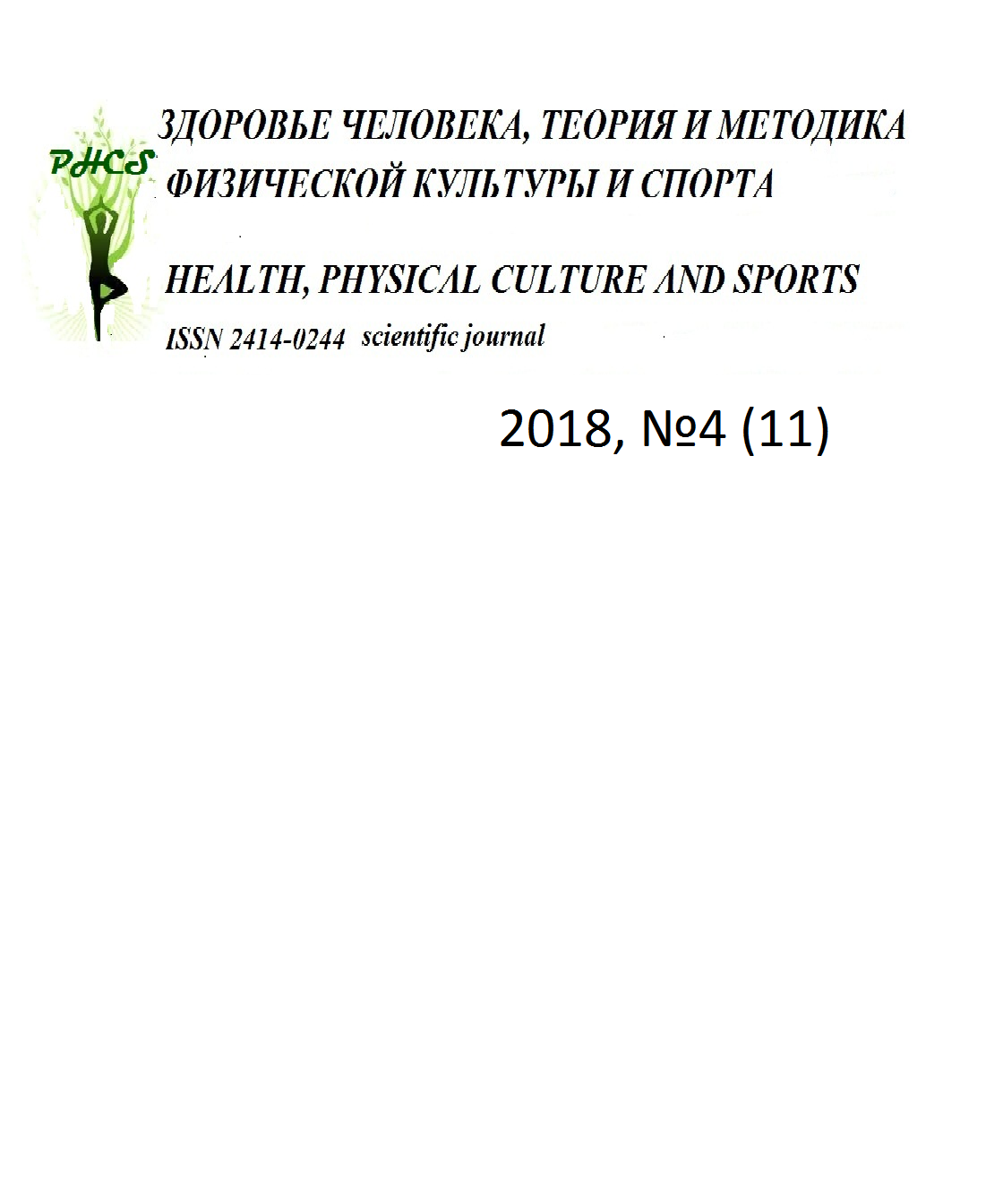Профилактика пищевой аллергии у студентов вуза средствами оздоровительной физической культуры
Abstract
. This article is devoted to one of the most pressing problems of the modernity - the problem of preventing food allergies in young people. According to the World Health Organization, allergy is the third largest prevalence in the world. Allergies are often the cause of diseases of the upper respiratory tract and organs of the gastrointestinal tract. Most often, food allergies are manifested in people who were treated with antibiotics at an early age, as well as in those with intestinal dysbacteriosis. The main directions in the prevention and treatment of allergic reactions is a comprehensive approach and consistency in the implementation of various therapeutic and preventive measures aimed at eliminating the symptoms of allergies, and at preventing exacerbations of its manifestations. In food allergies, the appointment of an adequate nutrition that is appropriate in terms of the volume and ratio of food ingredients to age, weight of the diseased, concomitant somatic diseases and other factors is of paramount importance. The exclusion from the diet of a causally significant food allergen, refers to the main methods of treatment of food allergies. From a practical point of view, it is important for each person to know what kind of foodstuffs have an allergic potential. The article presents the results of a sociological study conducted with students of a special medical department of the Altai State University. As part of the research, the authors consider the concept and essence of food allergy, the main causes and factors that provoke its occurrence in the student age category, and offer basic methods for the prevention of this disease.
Downloads
References
2. Василевский И.В., Федорович С.В. Современные клинико-фармакологические подходы к лечению аллергических заболеваний // Аллергология. Профпатология. Гигиена. Дерматология.- Минск.- 2014.- С. 143 – 155.
3. Василевский И.В. Клинические проявления аллергических заболеваний пищеварительного тракта // Медицинские знания.- 2015.- № 2.- С. 3 – 8.
4. Мачарадзе Д.Ш. Лечение пищевой аллергии / Лечащий врач, 2016.- № 4.
5. Подшивалова В.А. Боремся с аллергией. [Текст]/ В.А. Подшивалова.- М.: 2010. - 47с.
6. Цыган В.Н., Скальный А.В., Мокеева Е.Г., Спорт. Иммунитет. Питание / В.Н. Цыган, А.В. Скальный, Е.Г. Мокеева; Федерал. гос. бюджет. учреждение науки "Ин-т токсикологии Федерал. мед.-биол. агентства". - Санкт-Петербург: ЭЛБИ-СПб, 2012.- 239 с.
7. Физическая культура. Основы здорового образа жизни: учебное пособие/ Ю.П.Кобяков. – Изд.2-е – Ростов-на-Дону: Феникс, 2014. – 252, с. 167.
8. Романова Е.В., Дугнист П.Я. Изучение мнения студентов о здоровом образе жизни. Здоровье человека, теория и методика физической культуры и спорта: материалы Международной научно-практической конференции / под общ.ред. П.Я.Дугниста, П.Г.Воронцова, Е.В.Романовой. – Барнаул: Изд-во Алт.ун-та,2015. – 232 с, с. 144.
9. Хакимова Р. Ф. К вопросу о пищевой аллергии у детей // ПМ. 2009. №35. С. 37-40.
10. Пампура Александр Николаевич Принципы первичной диетопрофилактики аллергических заболеваний у детей // ВСП. 2009. №3. URL: https://cyberleninka.ru/article/n/printsipy-pervichnoy-dietoprofilaktiki-allergicheskih-zabolevaniy-u-detey (дата обращения: 06.12.2018).
11. Кудрявцева А. В., Боровик Т. Э., Макарова Светлана Геннадиевна Сочетанные кожные и респираторные проявления пищевой аллергии у детей: этиология, клиника, комплексная терапия // ВСП. 2010. №2. С. 74-81. - URL: https://cyberleninka.ru/article/n/sochetannye-kozhnye-i-respiratornye-proyavleniya-pischevoy-allergii-u-detey-etiologiya-klinika-kompleksnaya-terapiya (дата обращения: 06.12.2018).
REFERENCES
1. Ado V.A., Goryachkina L.A., Mayanskii D.N. 2011. Allergiya. Novosibirsk: Nauka. 57 p. (In Russian)
2. Vasilevskii I.V., Fedorovich S.V. 2014. Sovremennye kliniko-farmakologicheskie podkhody k lecheniyu allergicheskikh zabolevanii. Allergologiya. Profpatologiya. Gigiena. Dermatologiya. Minsk. pp. 143 – 155.
3. Vasilevskii I.V. 2015. Klinicheskie proyavleniya allergicheskikh zabolevanii pishchevaritel'nogo trakta. Meditsinskie znaniya, 2, pp. 3-8. (In Russian)
4. Macharadze D.Sh. 2016. Lechenie pishchevoi allergii. Lechashchii vrach, 4.
5. Podshivalova V.A. 2010. Boremsya s allergiei. Moscow, 47 p. (In Russian)
6. Tsygan V.N., Skal'nyi A.V., Mokeeva E.G., 2012. Sport. Immunitet. Pitanie / V.N. Tsygan, A.V. Skal'nyi, E.G. Mokeeva; Federal. gos. byudzhet. uchrezhdenie nauki "In-t toksikologii Federal. med.-biol. agentstva". - Sankt-Peterburg: ELBI-SPb, 239 p. (In Russian)
7. Fizicheskaya kul'tura. Osnovy zdorovogo obraza zhizni: uchebnoe posobie. 2014. Yu.P.Kobyakov. Rostov-na-Donu: Feniks, 252, p. 167. (In Russian)
8. Romanova E.V., Dugnist P.Ya. 2015. Izuchenie mneniya studentov o zdorovom obraze zhizni. Zdorov'e cheloveka, teoriya i metodika fizicheskoi kul'tury i sporta: materialy Mezhdunarodnoi nauchno-prakticheskoi konferentsii. pod obshch.red. P.Ya.Dugnista, P.G.Vorontsova, E.V.Romanovoi. Barnaul: Izd-vo Alt.un-ta, 232 p., p. 144. (In Russian)
9. Khakimova R. F. 2009. K voprosu o pishchevoi allergii u detei. PM, 35, pp. 37-40. (In Russian)
10. Pampura A. N. 2009. Printsipy pervichnoi dietoprofilaktiki allergicheskikh zabolevanii u detei. VSP, 3. (In Russian) - URL: https://cyberleninka.ru/article/n/printsipy-pervichnoy-dietoprofilaktiki-allergicheskih-zabolevaniy-u-detey (Аccessed: 06.11.2018).
11. Kudryavtseva A. V., Borovik T. E., Makarova S. G. 2010. Sochetannye kozhnye i respiratornye proyavleniya pishchevoi allergii u detei: etiologiya, klinika, kompleksnaya terapiya. VSP, 2, pp. 74-81. (In Russian). - URL: https://cyberleninka.ru/article/n/sochetannye-kozhnye-i-respiratornye-proyavleniya-pischevoy-allergii-u-detey-etiologiya-klinika-kompleksnaya-terapiya (Аccessed: 06.11.2018).

An author should not normally publish manuscripts describing essentially the same research in multiple journals or publication venues. Such redundant publication is generally considered to constitute unethical publishing behavior, and if discovered may result in a manuscript under consideration being rejected, or a published article being retracted.
Authors of manuscripts reporting on original research should present an accurate account of the work performed, accompanied by an objective discussion of its significance. Underlying data should be represented accurately in the manuscript. The manuscript should contain sufficient detail and references to permit others to replicate the work. The fabrication of results and the making of fraudulent or knowingly inaccurate statements constitute unethical behavior and may be cause for rejection or retraction of a manuscript or published article.




